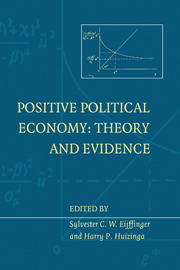Book contents
- Frontmatter
- Contents
- List of figures
- List of tables
- List of contributors
- Foreword
- Introduction
- I Monetary institutions and policy
- 1 Reputational versus institutional solutions to the time-consistency problem in monetary policy
- 2 Reciprocity and political business cycles in federal monetary unions
- 3 The ultimate determinants of central bank independence
- Comment
- 4 Central bank autonomy and exchange rate regimes – their effects on monetary accommodation and activism
- 5 Uncertainty, instrument choice, and the uniqueness of Nash equilibrium: microeconomic and macroeconomic examples
- 6 New empirical evidence on the costs of European Monetary Union
- II Exchange rate policy and redistribution
- Index
Comment
from 3 - The ultimate determinants of central bank independence
Published online by Cambridge University Press: 05 September 2013
- Frontmatter
- Contents
- List of figures
- List of tables
- List of contributors
- Foreword
- Introduction
- I Monetary institutions and policy
- 1 Reputational versus institutional solutions to the time-consistency problem in monetary policy
- 2 Reciprocity and political business cycles in federal monetary unions
- 3 The ultimate determinants of central bank independence
- Comment
- 4 Central bank autonomy and exchange rate regimes – their effects on monetary accommodation and activism
- 5 Uncertainty, instrument choice, and the uniqueness of Nash equilibrium: microeconomic and macroeconomic examples
- 6 New empirical evidence on the costs of European Monetary Union
- II Exchange rate policy and redistribution
- Index
Summary
Eijffinger and Schaling (for the sake of brevity, I shall refer to them as ES) have written an interesting and stimulating chapter. For some years now, the literature has paid considerable attention to the measurement of central bank independence and to its relationship with other economic variables. Time therefore has come to look more closely at the factors that explain the degree of central bank independence. In their chapter, ES make an original contribution in this area. On the basis of a formal model, they derive four factors governing the optimal degree of central bank independence. Using the latent-variables method, they then estimate the relationship between the optimal degree of central bank independence and these variables for 19 countries. Finally, they compare the actual with the optimal degree of central bank independence. The estimation period is 1960–93.
The variable ∊ plays a crucial role in the model of ES. This variable measures, or is at any rate a proxy for, the degree of central bank independence. I am not convinced of this, ∊ indicates to what extent price stability carries more weight in the central bank's loss function than in the social loss function. The greater the value of the variable ∊, the greater the degree of central bank independence. In my view, however, independence has primarily to do with the extent to which the central bank is able make decisions without government interference. That is not exactly measured by the variable ∊.
- Type
- Chapter
- Information
- Positive Political EconomyTheory and Evidence, pp. 74 - 77Publisher: Cambridge University PressPrint publication year: 1998



